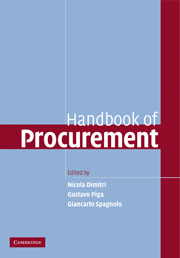Book contents
- Frontmatter
- Contents
- List of figures
- List of tables
- List of contributors
- Preface
- Part I Preliminary Issues
- Part II General Strategic Principles
- Part III Competitive Tendering Strategies
- 6 Information and competitive tendering
- 7 Division into lots and competition in procurement
- 8 Multi-contract tendering procedures and package bidding in procurement
- 9 Dynamic auctions in procurement
- Part IV Attracting and Screening Participants
- Part V Preventing Collusion and Corruption
- Part VI Dynamic Forces and Innovation
- Glossary
- Index
- References
7 - Division into lots and competition in procurement
Published online by Cambridge University Press: 04 November 2009
- Frontmatter
- Contents
- List of figures
- List of tables
- List of contributors
- Preface
- Part I Preliminary Issues
- Part II General Strategic Principles
- Part III Competitive Tendering Strategies
- 6 Information and competitive tendering
- 7 Division into lots and competition in procurement
- 8 Multi-contract tendering procedures and package bidding in procurement
- 9 Dynamic auctions in procurement
- Part IV Attracting and Screening Participants
- Part V Preventing Collusion and Corruption
- Part VI Dynamic Forces and Innovation
- Glossary
- Index
- References
Summary
Introduction
A buyer always has the choice to procure a good or service with a single contract or divide it into several contracts. On the one hand, large firms and centralized public procurement agencies often find it optimal to divide supply into smaller, local lots because of the transportation costs linked to geographical dispersion. On the other hand, complementarities between different parts of the contract would suggest advantages from bundling them. But the division into lots has other important effects. By specifying the size of each lot, the division of a supply contract determines which potential suppliers have sufficient capacity to participate in each separate competitive tendering (for at least one lot), and which do not. By influencing participation, the division into lots has an important impact on the participants’ behaviour and on the final outcome. The division into lots also determines how a procurement contract can be ‘split’ among potential competitors, hence how easy it is for bidders to achieve and sustain implicit or explicit collusive agreements to share the supply at inflated prices.
Existing economic analysis provides only limited guidance when it comes to deciding the number of lots into which a supply contract should be divided, and deciding about their sizes. The reason is that standard textbooks usually consider cases with a fixed number of objects.
- Type
- Chapter
- Information
- Handbook of Procurement , pp. 168 - 192Publisher: Cambridge University PressPrint publication year: 2006
References
- 8
- Cited by

